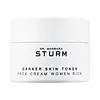What's inside
What's inside
 Key Ingredients
Key Ingredients

 Benefits
Benefits

 Concerns
Concerns

 Ingredients Side-by-side
Ingredients Side-by-side

Water
Skin ConditioningGlyceryl Stearate Citrate
EmollientMacadamia Integrifolia Seed Oil
Skin ConditioningGlycerin
HumectantCaprylic/Capric Triglyceride
MaskingButylene Glycol
HumectantCetearyl Alcohol
EmollientCocoglycerides
EmollientDecyl Oleate
EmollientLactobacillus/Portulaca Oleracea Ferment Extract
AntioxidantCoco-Caprylate
EmollientSqualane
EmollientTocopheryl Acetate
AntioxidantMaris Aqua
HumectantPanthenol
Skin ConditioningEnantia Chlorantha Bark Extract
Skin ConditioningSodium Lactate
BufferingSodium PCA
HumectantAllantoin
Skin ConditioningTeprenone
Skin ConditioningSodium Hyaluronate
HumectantHydrolyzed Algae Extract
Skin ConditioningLeuconostoc/Radish Root Ferment Filtrate
AntimicrobialMagnolia Officinalis Bark Extract
AntimicrobialFructose
HumectantGlycine
BufferingTocopherol
AntioxidantInositol
HumectantLactic Acid
BufferingNiacinamide
SmoothingUrea
BufferingOleanolic Acid
Skin ConditioningAscorbic Acid
AntioxidantVitis Vinifera Seed Extract
AntimicrobialCarbomer
Emulsion StabilisingMaltodextrin
AbsorbentXanthan Gum
EmulsifyingLecithin
EmollientEthylhexylglycerin
Skin ConditioningSodium Hydroxide
BufferingDisodium EDTA
Alcohol
AntimicrobialPantolactone
HumectantAscorbyl Palmitate
AntioxidantCitric Acid
BufferingSodium Benzoate
MaskingPhenoxyethanol
PreservativeWater, Glyceryl Stearate Citrate, Macadamia Integrifolia Seed Oil, Glycerin, Caprylic/Capric Triglyceride, Butylene Glycol, Cetearyl Alcohol, Cocoglycerides, Decyl Oleate, Lactobacillus/Portulaca Oleracea Ferment Extract, Coco-Caprylate, Squalane, Tocopheryl Acetate, Maris Aqua, Panthenol, Enantia Chlorantha Bark Extract, Sodium Lactate, Sodium PCA, Allantoin, Teprenone, Sodium Hyaluronate, Hydrolyzed Algae Extract, Leuconostoc/Radish Root Ferment Filtrate, Magnolia Officinalis Bark Extract, Fructose, Glycine, Tocopherol, Inositol, Lactic Acid, Niacinamide, Urea, Oleanolic Acid, Ascorbic Acid, Vitis Vinifera Seed Extract, Carbomer, Maltodextrin, Xanthan Gum, Lecithin, Ethylhexylglycerin, Sodium Hydroxide, Disodium EDTA, Alcohol, Pantolactone, Ascorbyl Palmitate, Citric Acid, Sodium Benzoate, Phenoxyethanol
Alternatives
Ingredients Explained
These ingredients are found in both products.
Ingredients higher up in an ingredient list are typically present in a larger amount.
Glycerin is already naturally found in your skin. It helps moisturize and protect your skin.
A study from 2016 found glycerin to be more effective as a humectant than AHAs and hyaluronic acid.
As a humectant, it helps the skin stay hydrated by pulling moisture to your skin. The low molecular weight of glycerin allows it to pull moisture into the deeper layers of your skin.
Hydrated skin improves your skin barrier; Your skin barrier helps protect against irritants and bacteria.
Glycerin has also been found to have antimicrobial and antiviral properties. Due to these properties, glycerin is often used in wound and burn treatments.
In cosmetics, glycerin is usually derived from plants such as soybean or palm. However, it can also be sourced from animals, such as tallow or animal fat.
This ingredient is organic, colorless, odorless, and non-toxic.
Glycerin is the name for this ingredient in American English. British English uses Glycerol/Glycerine.
Learn more about GlycerinPanthenol is a common ingredient that helps hydrate and soothe the skin. It is found naturally in our skin and hair.
There are two forms of panthenol: D and L.
D-panthenol is also known as dexpanthenol. Most cosmetics use dexpanthenol or a mixture of D and L-panthenol.
Panthenol is famous due to its ability to go deeper into the skin's layers. Using this ingredient has numerous pros (and no cons):
Like hyaluronic acid, panthenol is a humectant. Humectants are able to bind and hold large amounts of water to keep skin hydrated.
This ingredient works well for wound healing. It works by increasing tissue in the wound and helps close open wounds.
Once oxidized, panthenol converts to pantothenic acid. Panthothenic acid is found in all living cells.
This ingredient is also referred to as pro-vitamin B5.
Learn more about PanthenolTocopherol (also known as Vitamin E) is a common antioxidant used to help protect the skin from free-radicals and strengthen the skin barrier. It's also fat soluble - this means our skin is great at absorbing it.
Vitamin E also helps keep your natural skin lipids healthy. Your lipid skin barrier naturally consists of lipids, ceramides, and fatty acids. Vitamin E offers extra protection for your skin’s lipid barrier, keeping your skin healthy and nourished.
Another benefit is a bit of UV protection. Vitamin E helps reduce the damage caused by UVB rays. (It should not replace your sunscreen). Combining it with Vitamin C can decrease sunburned cells and hyperpigmentation after UV exposure.
You might have noticed Vitamin E + C often paired together. This is because it is great at stabilizing Vitamin C. Using the two together helps increase the effectiveness of both ingredients.
There are often claims that Vitamin E can reduce/prevent scarring, but these claims haven't been confirmed by scientific research.
Learn more about TocopherolUrea is also called carbamide and is the diamide of carbonic acid. In cosmetics, urea is used to hydrate the skin. It also provides exfoliation in higher concentrations.
As a humectant, urea helps draw moisture from the air and from deep within the skin. This helps hydrate your skin. Studies show urea is an effective moisturizer for dry skin conditions. 40% urea is typical in medications for treating eczema and other skin conditions.
Urea has the strongest exfoliation effect in concentrations higher than 10%. It is a keratolytic agent, meaning it breaks down the keratin protein in the top layer of skin. This helps remove dead skin cells and flaking skin.
In medicine, urea has been shown to help increase the potency of other ingredients, such as fungal treatments.
Humans and animals use urea to metabolize nitrogen-containing compounds. Urea is highly soluble in water. Once dissolved, it is neither acidic nor alkaline.
Learn more about Urea